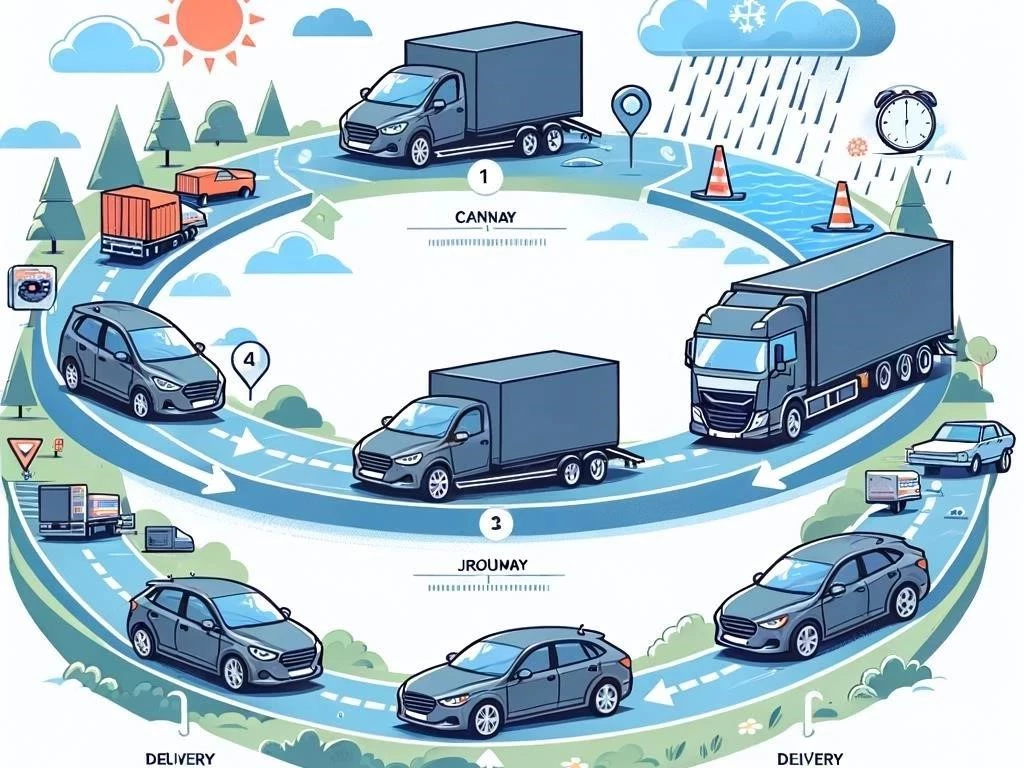How Long Does It Take to Ship a Car?
Shipping a car involves various factors influencing car shipping time, including transport methods, distance, and vehicle specifics, affecting overall vehicle transport duration significantly.
Understanding Car Shipping Time
Car shipping time refers to the total duration from when a vehicle is picked up until it reaches its destination. This time frame can vary significantly based on several factors. Understanding these factors is crucial for those planning to transport their vehicles. Different shipping methods, such as open carrier or enclosed transport, offer different transit periods for cars. Additionally, the distance between pickup and delivery locations, as well as any potential shipping delays, can impact the overall timeline. Knowing these elements helps you better anticipate your vehicle’s arrival and manage expectations effectively.
Factors Affecting Shipping Time
Several key factors significantly affect car shipping time and should be considered when planning vehicle transport. Firstly, the distance of transport plays a crucial role; longer distances generally lead to longer shipping durations. Secondly, the shipping method chosen, whether open carrier or enclosed transport, influences the timeline. Additionally, the time of year can impact logistics for car transport, as demand fluctuates seasonally. Lastly, the vehicle’s condition and type also affect shipping time, with certain vehicles requiring special handling that may extend the overall transit period for cars. Understanding these factors enhances planning efficiency.
2.1 Distance of Transport
The distance of transport significantly impacts the overall car shipping time. Generally, shorter distances result in quicker transit periods for cars, while longer distances can extend the timeline considerably. For instance, local shipments may take just a few days, whereas cross-country car shipping can range from one to two weeks or more, depending on various conditions. Additionally, factors such as traffic, weather, and route efficiency can further influence delivery estimates for vehicles. Understanding the distance involved allows customers to set realistic expectations and better plan for their vehicle’s arrival at the destination.
2.2 Shipping Method Chosen
The shipping method chosen greatly affects the overall car shipping time and should be carefully considered. There are two primary options: open carrier and enclosed transport. Open carrier shipping duration tends to be shorter and more cost-effective, making it a popular choice for many customers. In contrast, enclosed transport, while offering additional protection for vehicles, often requires a longer transit period due to limited availability and specialized handling. Each method has its advantages, and understanding how these choices impact logistics for car transport can help you select the best option for your needs.
2.3 Time of Year
The time of year significantly influences car shipping time due to variations in demand and weather conditions. Peak seasons, typically during summer or holidays, can lead to increased shipping delays as logistics for car transport become strained. Conversely, transporting vehicles during off-peak periods may result in faster service and potentially lower costs. Additionally, inclement weather during certain months, such as winter storms, can hinder transport efficiency, further extending delivery estimates for vehicles. Understanding seasonal trends allows customers to plan their shipments more effectively, ultimately impacting the overall auto shipping timeline.
2.4 Vehicle Condition and Type
The condition and type of the vehicle being shipped can significantly impact the overall car shipping time. For instance, classic or modified cars often require special handling, which may extend the shipping duration due to specific transport needs. Additionally, vehicles in poor condition might necessitate extra precautions, affecting logistics for car transport. Furthermore, larger vehicles or those with unusual dimensions may also require specialized carriers, leading to longer transit periods. Understanding these factors ensures that customers are well-informed about potential delays and can plan their auto shipping timeline accordingly for efficient transport.
Vehicle Transport Duration for Different Shipping Methods
Understanding vehicle transport duration for different shipping methods is crucial for effective planning. Open carrier shipping typically offers faster transit times, as these carriers can accommodate multiple vehicles simultaneously. Generally, this method can take anywhere from 1 to 2 weeks, depending on distance. In contrast, enclosed transport shipping time may be longer due to limited availability and the need for specialized handling, often ranging from 1 to 3 weeks. Each method serves specific needs, and knowing the differences helps customers make informed decisions regarding their auto shipping timeline and expectations.
3.1 Open Carrier Shipping Duration
Open carrier shipping duration is typically one of the fastest options available for vehicle transport. This method allows carriers to transport multiple vehicles simultaneously, optimizing efficiency and reducing overall shipping time. Generally, the transit period for cars shipped via open carriers can range from 1 to 2 weeks, depending on distance, logistics, and route conditions. Factors such as traffic, weather, and any potential shipping delays can also influence the timeline. Customers should consider these variables when selecting this cost-effective option, ensuring that they have realistic expectations regarding their vehicle’s delivery estimate.
3.2 Enclosed Transport Shipping Time
Enclosed transport shipping time is generally longer than that of open carriers due to the specialized nature of this service. Vehicles transported in enclosed carriers are better protected from environmental factors, but the limited availability of these carriers can extend the shipping duration. Typically, the transit period for enclosed transport ranges from 1 to 3 weeks, depending on distance and logistical considerations. Additionally, factors such as the type of vehicle, weather conditions, and potential shipping delays may further influence the timeline. Understanding these aspects helps customers manage their expectations regarding vehicle delivery estimates.
Auto Shipping Timeline for Domestic Transport
The auto shipping timeline for domestic transport can vary significantly based on several factors, including distance and shipping method. Generally, for local moves, the shipping time can range from 1 to 3 days. However, for cross-country car shipping, it typically takes between 1 to 2 weeks. Open carrier transport tends to be faster and more cost-effective, while enclosed transport may take longer due to specialized services. Customers should also account for potential shipping delays arising from traffic conditions, weather, or seasonal demand when estimating the overall delivery timeframe for their vehicles.
4.1 Estimated Arrival Time for Cross-Country Car Shipping
The estimated arrival time for cross-country car shipping varies based on multiple factors, including distance, route, and shipping method. Typically, when using open carriers, the timeframe ranges from 7 to 14 days for coast-to-coast transport. Enclosed transport, while offering more protection, generally extends this duration to around 10 to 21 days. Additionally, unforeseen circumstances such as weather conditions, traffic, and logistical challenges may cause shipping delays. Being aware of these variables allows customers to set realistic expectations regarding their vehicle’s arrival time and enhances overall planning for the shipping process.

4.2 Freight Shipping Time for Long Distance Car Shipping
Freight shipping time for long distance car shipping typically varies based on several factors, including distance, shipping method, and logistics involved. Generally, when opting for freight shipping, customers can expect transport durations ranging from 7 to 14 days for standard routes. However, factors such as the specific pickup and delivery locations, the type of carrier used, and any potential delays due to weather or traffic can further influence the overall shipping timeline. Understanding these elements helps customers better anticipate their vehicle’s arrival, ensuring informed planning for the shipping process.
International Car Shipping Timeframe
The international car shipping timeframe can vary greatly depending on several factors, including destination, shipping method, and customs clearance processes. Typically, shipping a vehicle overseas can take anywhere from 2 to 6 weeks. For example, ocean freight generally requires more time due to the distance and logistical complexities involved. Additionally, factors such as weather, port congestion, and the specific regulations of the destination country can further impact shipping times. Being aware of these variables is essential for customers to establish realistic expectations regarding their vehicle’s estimated arrival in a foreign location.
5.1 Shipping Delays in International Transport
Shipping delays in international transport can occur due to various factors that complicate the car shipping process. Customs clearance is often a significant cause of delays, as vehicles must meet specific regulations and documentation requirements in the destination country. Additionally, unforeseen circumstances such as adverse weather conditions, port congestion, and logistical challenges can hinder timely delivery. Moreover, the time of year, such as peak shipping seasons, can exacerbate delays. Understanding these potential issues allows customers to prepare for unexpected changes in their vehicle’s estimated arrival time during international shipping.
5.2 Logistics for Car Transport Across Borders
Logistics for car transport across borders involves various complexities that can impact the overall shipping timeframe. First, ensuring compliance with customs regulations is crucial, as each country has specific import and export requirements that must be met. Additionally, selecting the right shipping method, whether by sea or air, can significantly affect delivery times. Coordination between shipping companies, customs brokers, and freight forwarders is essential for smooth logistics. Factors such as route planning, seasonal demand, and potential delays at border crossings also play vital roles in determining how long it takes to ship a car internationally.
Pickup and Delivery Schedule
The pickup and delivery schedule is a critical aspect of the car shipping process, significantly influencing how long it takes to ship a car. The timeline begins with scheduling the pickup, which can vary based on the carrier’s availability and the vehicle’s location. Generally, customers can expect a window of several days to arrange this. Once the vehicle is in transit, the delivery schedule is based on distance, chosen shipping method, and logistical considerations. Clear communication with the shipping company can help customers stay informed and manage their expectations regarding the overall timeline for delivery.
6.1 Car Delivery Service and Its Impact on Timing
Car delivery service plays a significant role in determining how long it takes to ship a car. Different service levels, such as standard or expedited shipping, can dramatically affect delivery times. While standard delivery may take longer, expedited options often prioritize speed, potentially reducing transit time significantly. Additionally, the delivery service’s reliability and efficiency can influence overall shipping duration. Factors like the carrier’s experience, route optimization, and communication with customers also impact the timing. Understanding these aspects allows individuals to select the most suitable car delivery service for their needs and expectations.
6.2 Factors to Consider in Your Delivery Estimate for Vehicles
When estimating delivery times for vehicles, several key factors should be considered to ensure accuracy. First, the distance between the pickup and delivery locations greatly influences the shipping duration. Additionally, the chosen shipping method—whether open or enclosed carrier—can impact transit times. Seasonal conditions, such as weather or holiday traffic, may also cause delays. Furthermore, the vehicle’s condition and type can affect logistics, particularly if special handling is required. Lastly, communication with the shipping company can offer insights into potential delays, allowing for better planning and accurate delivery estimates.
Planning for your car shipping involves understanding various factors that influence the timeframe and ensuring a smooth process. By considering the distance, shipping method, and time of year, you can set realistic expectations for delivery. Additionally, being aware of potential shipping delays and logistics challenges can help you manage your timeline effectively. Communication with your chosen shipping company is crucial for updates and accurate delivery estimates. Ultimately, thorough planning enables you to navigate the complexities of vehicle transport, ensuring a seamless experience and timely arrival for your car at its destination.








